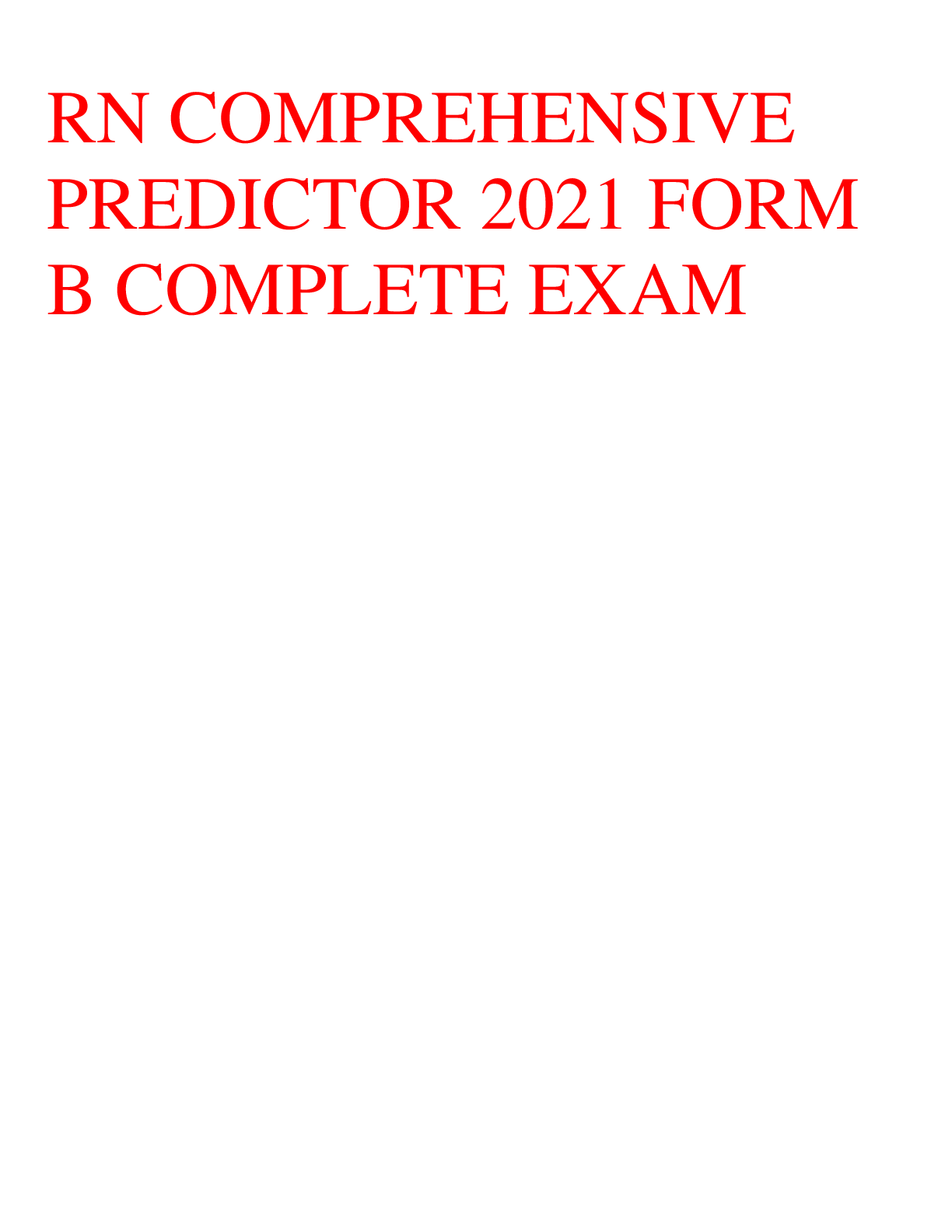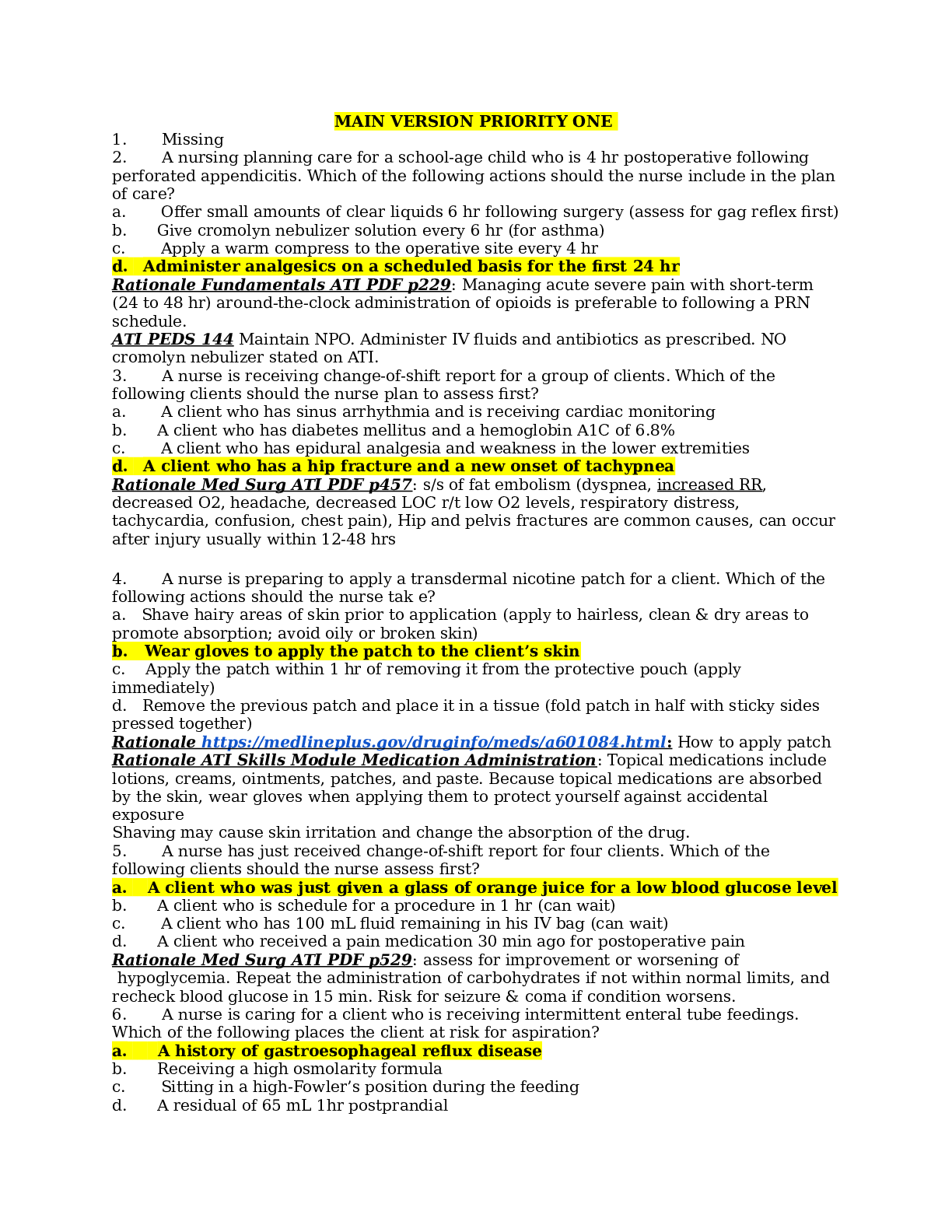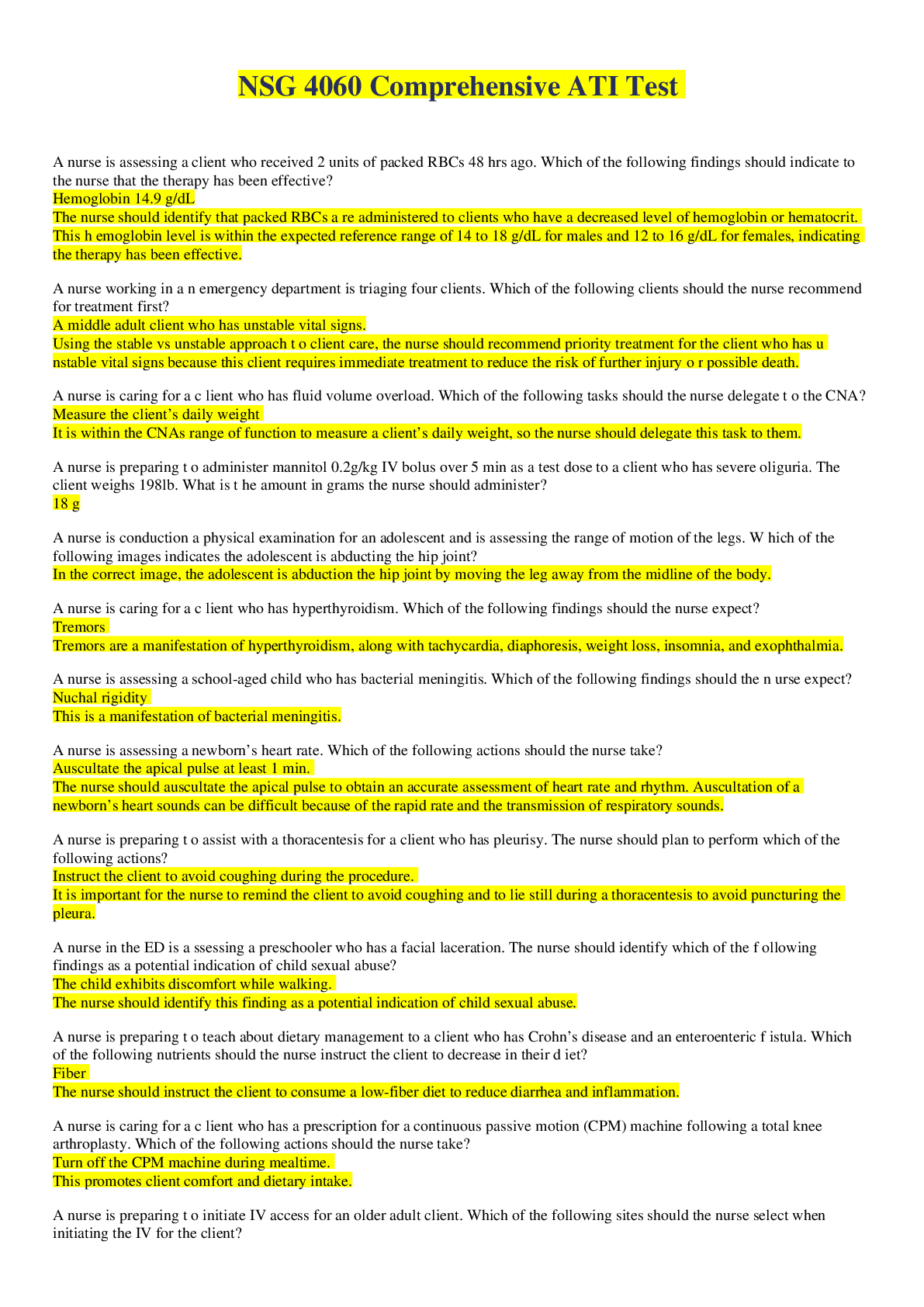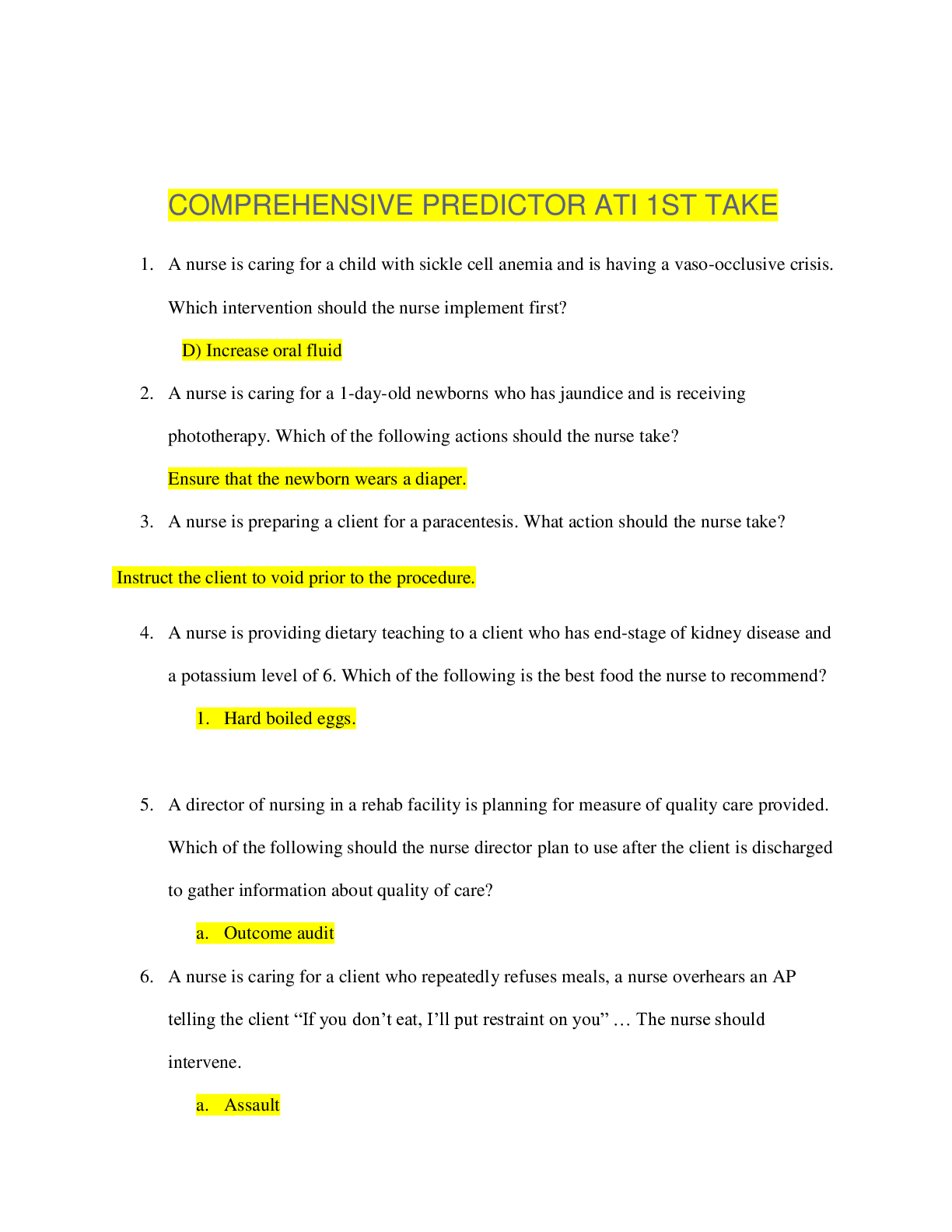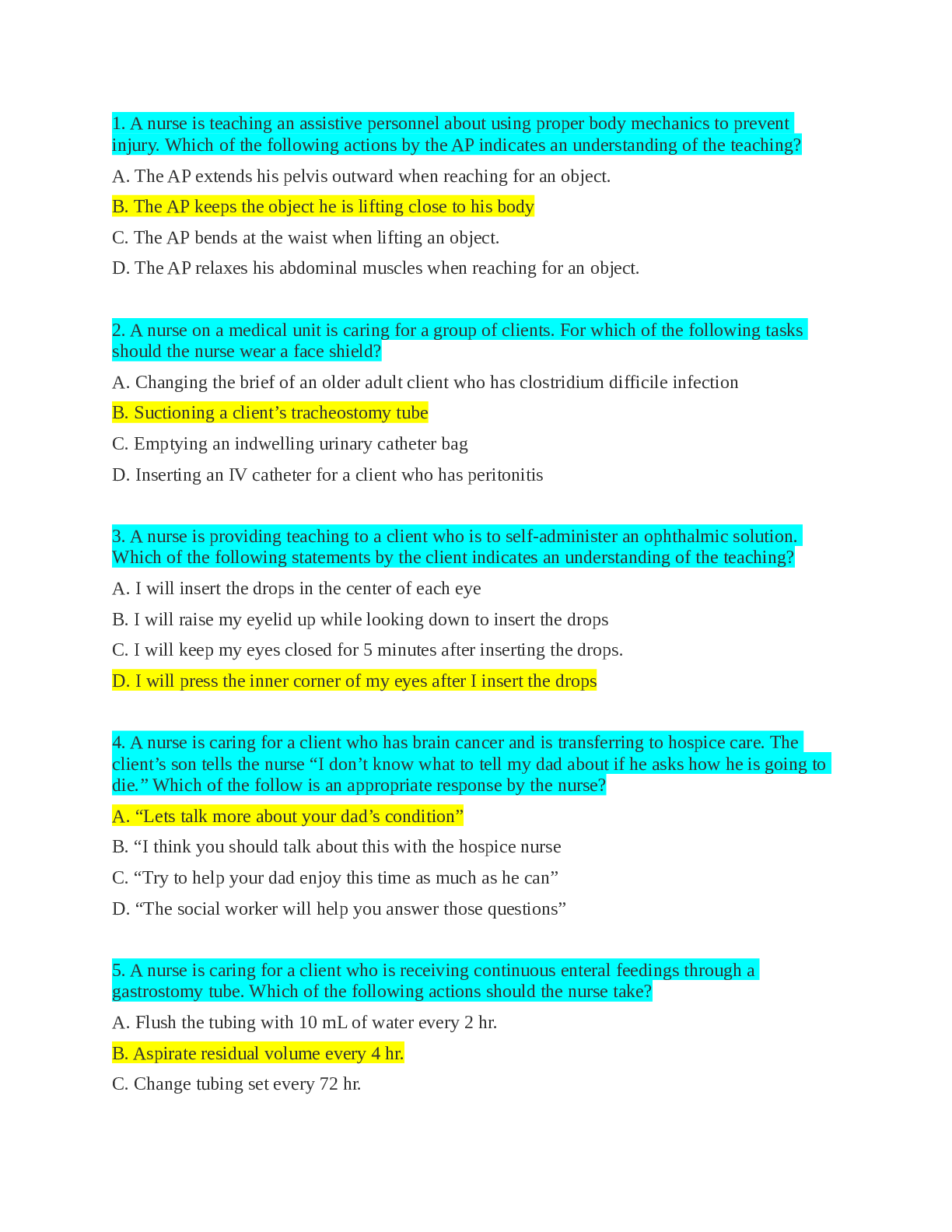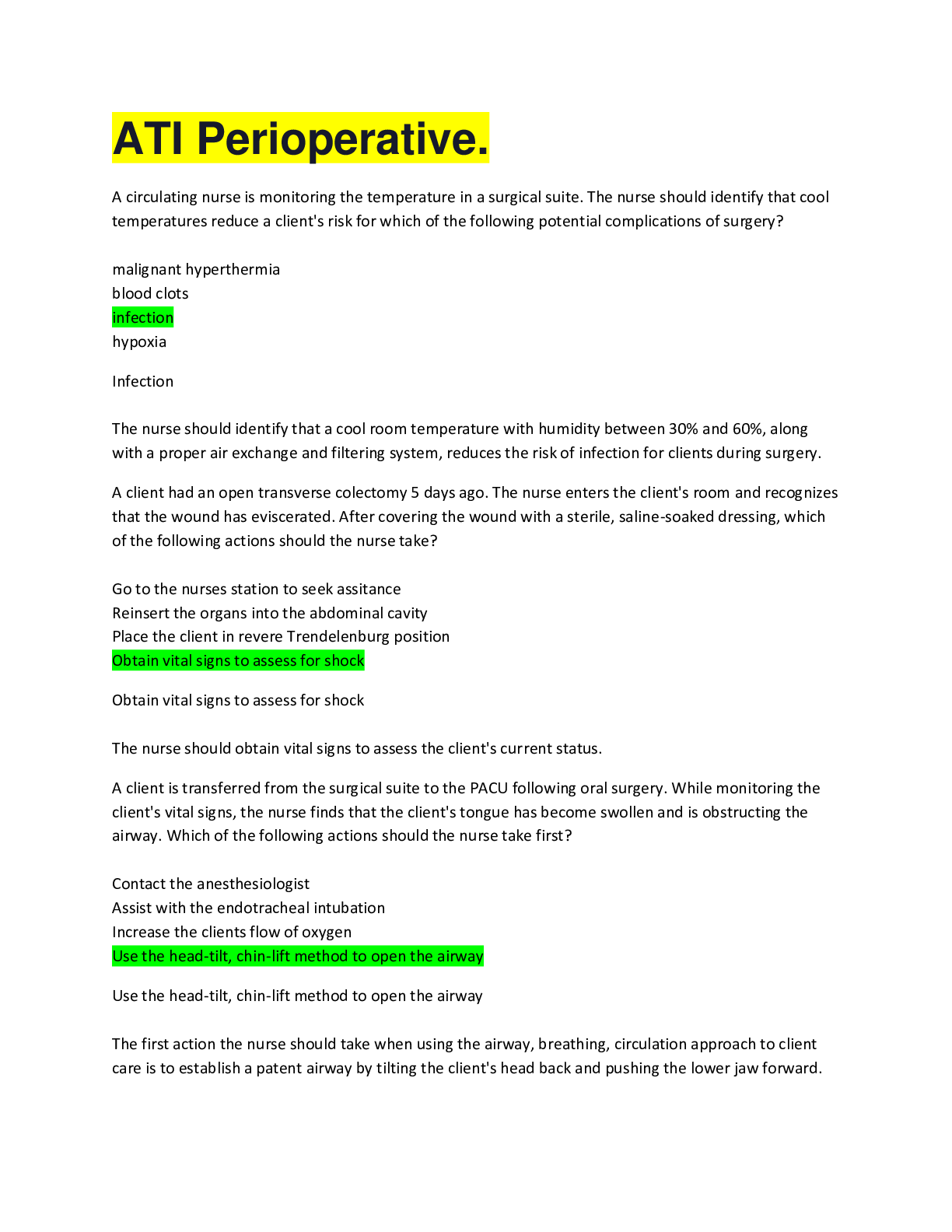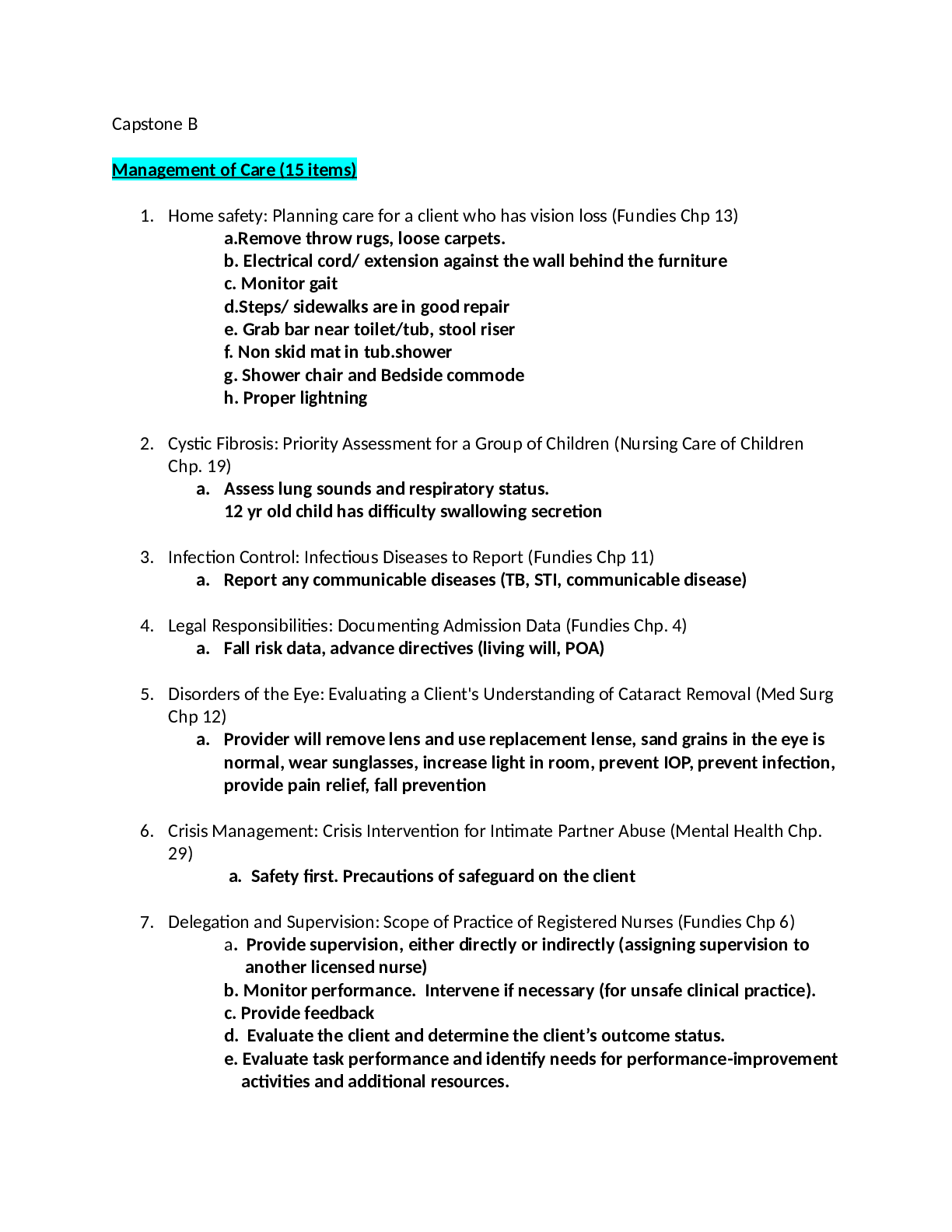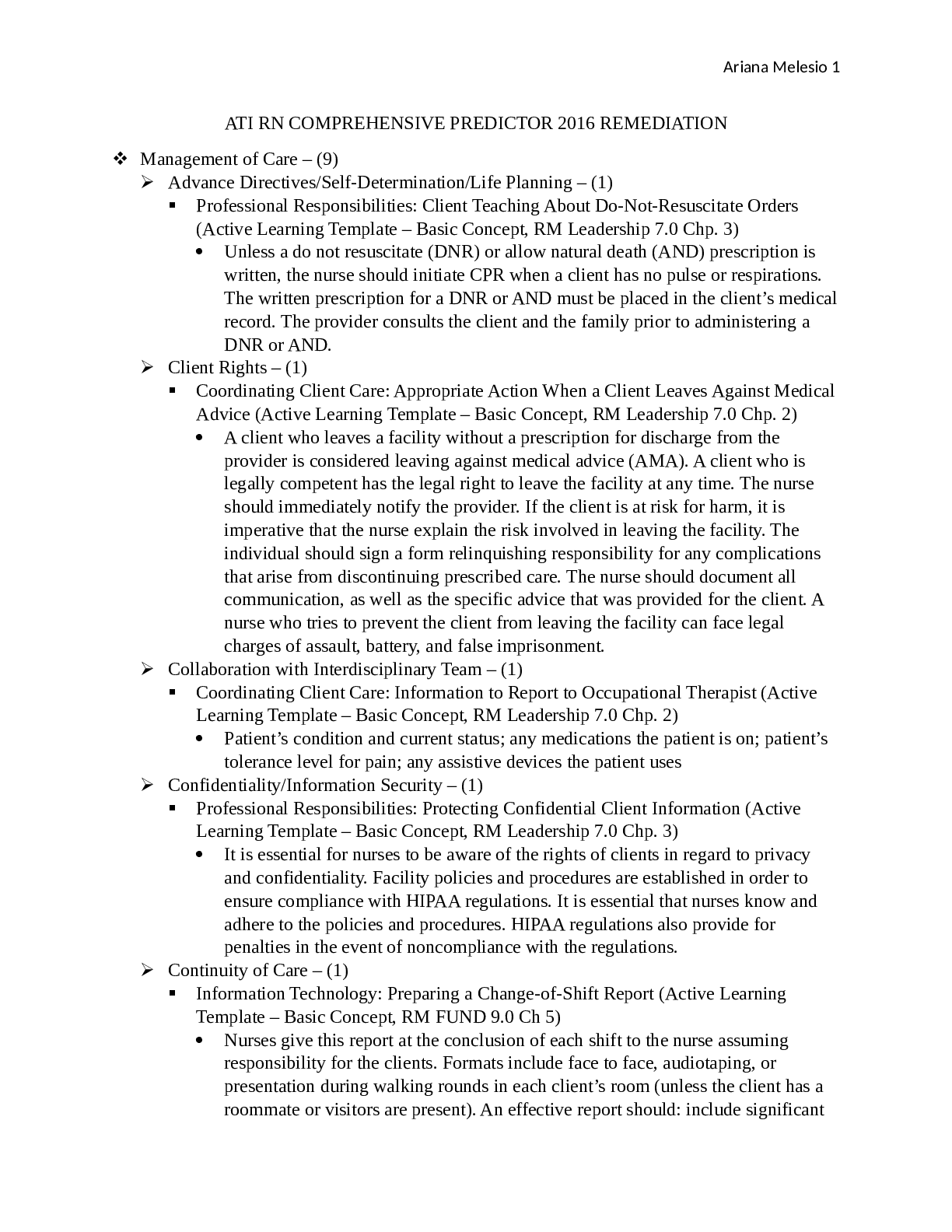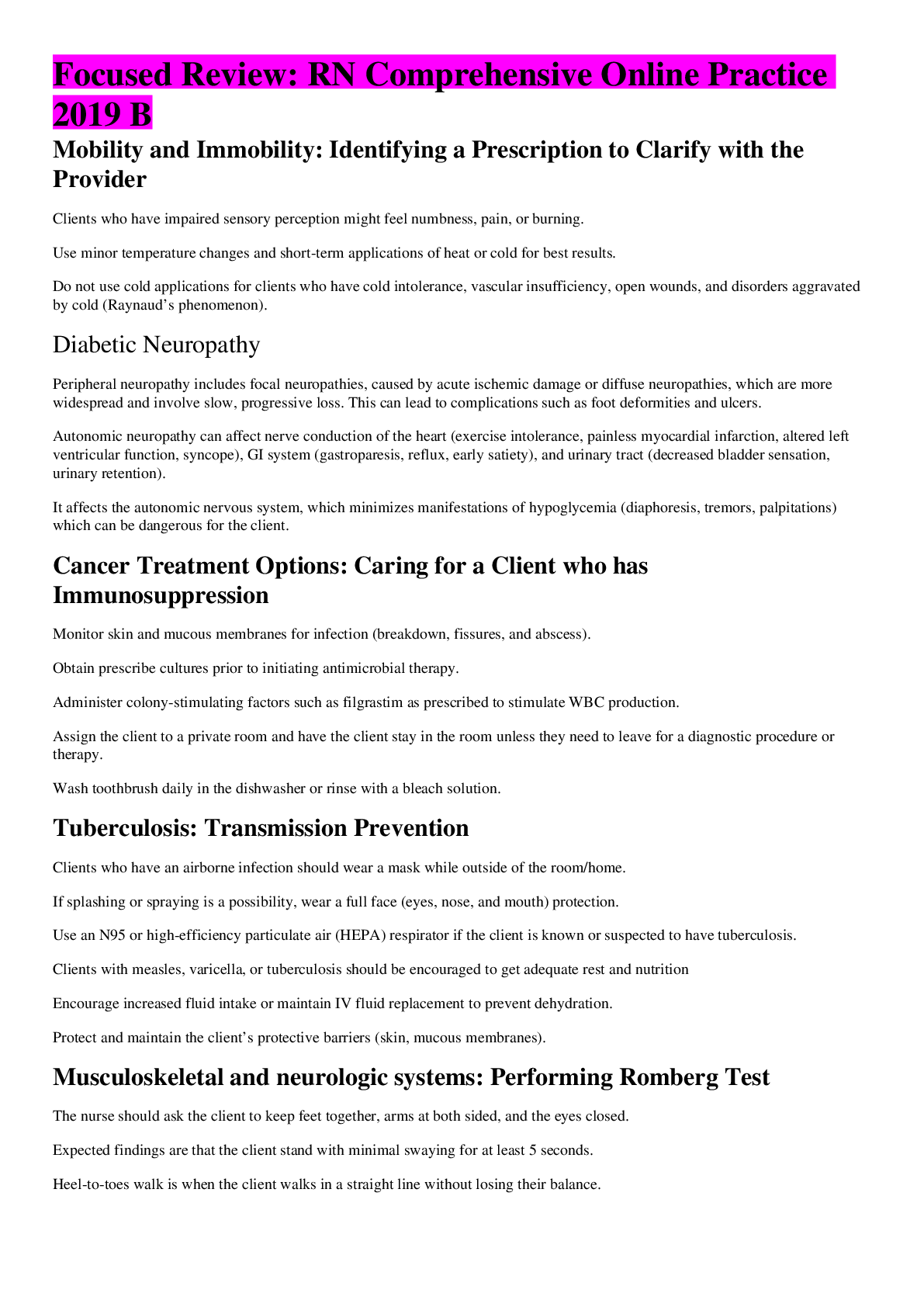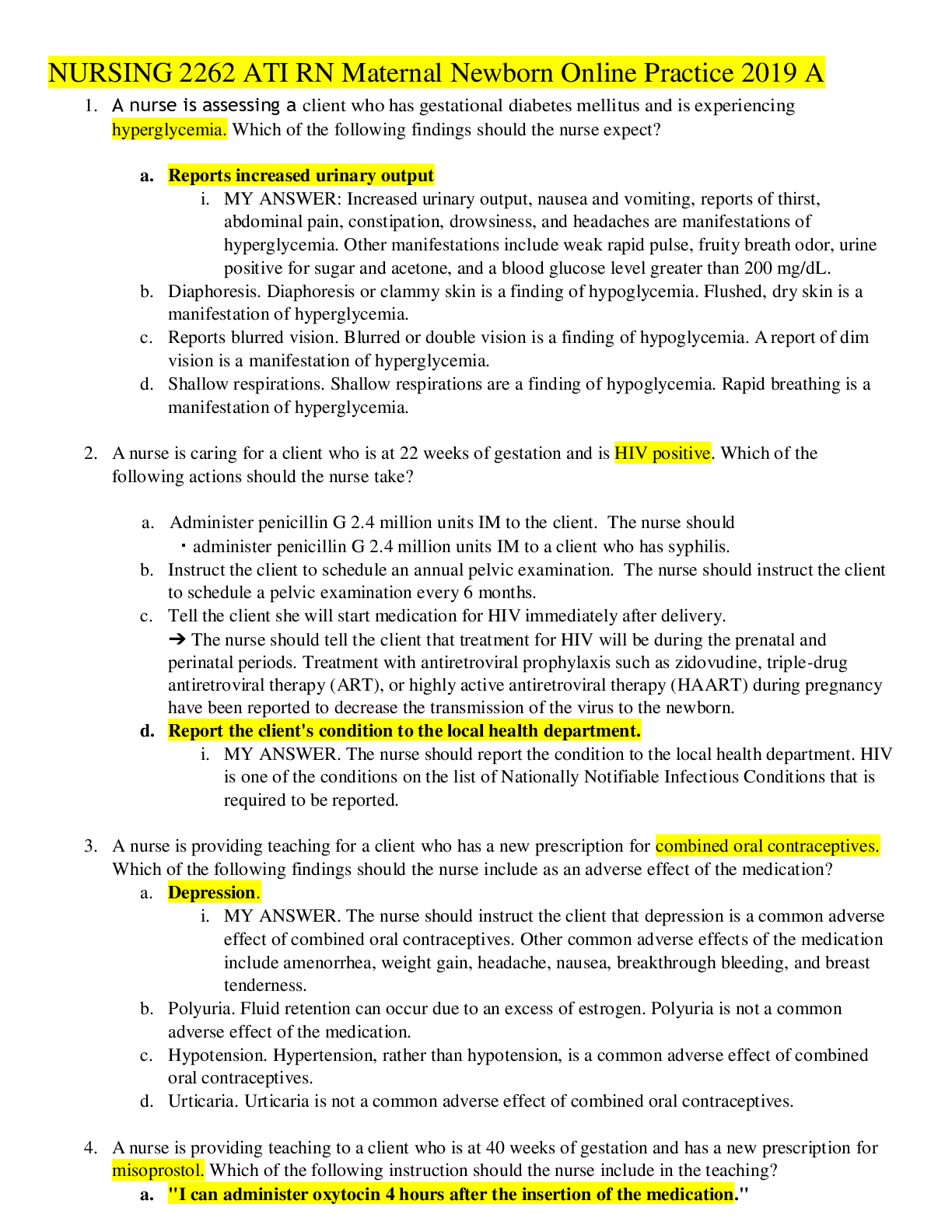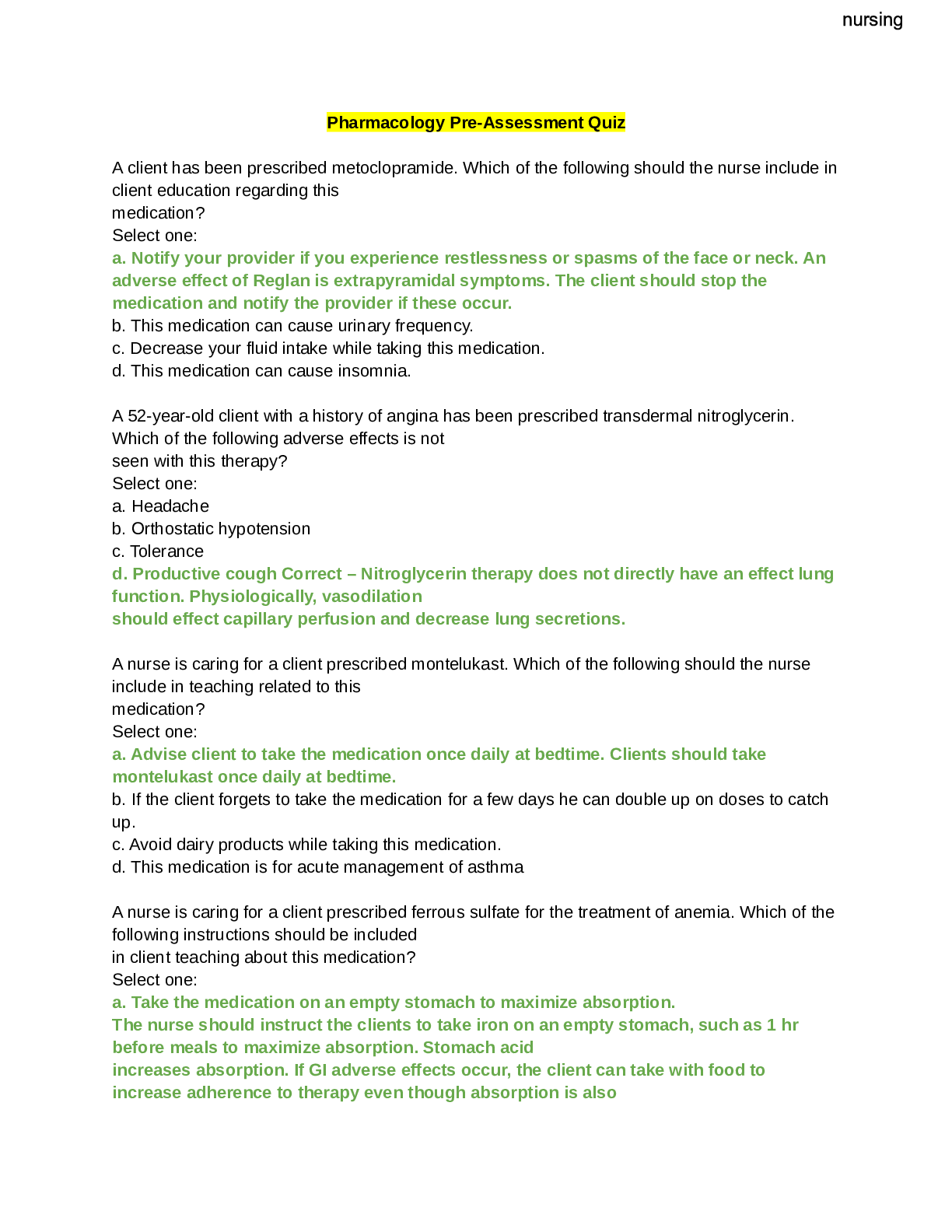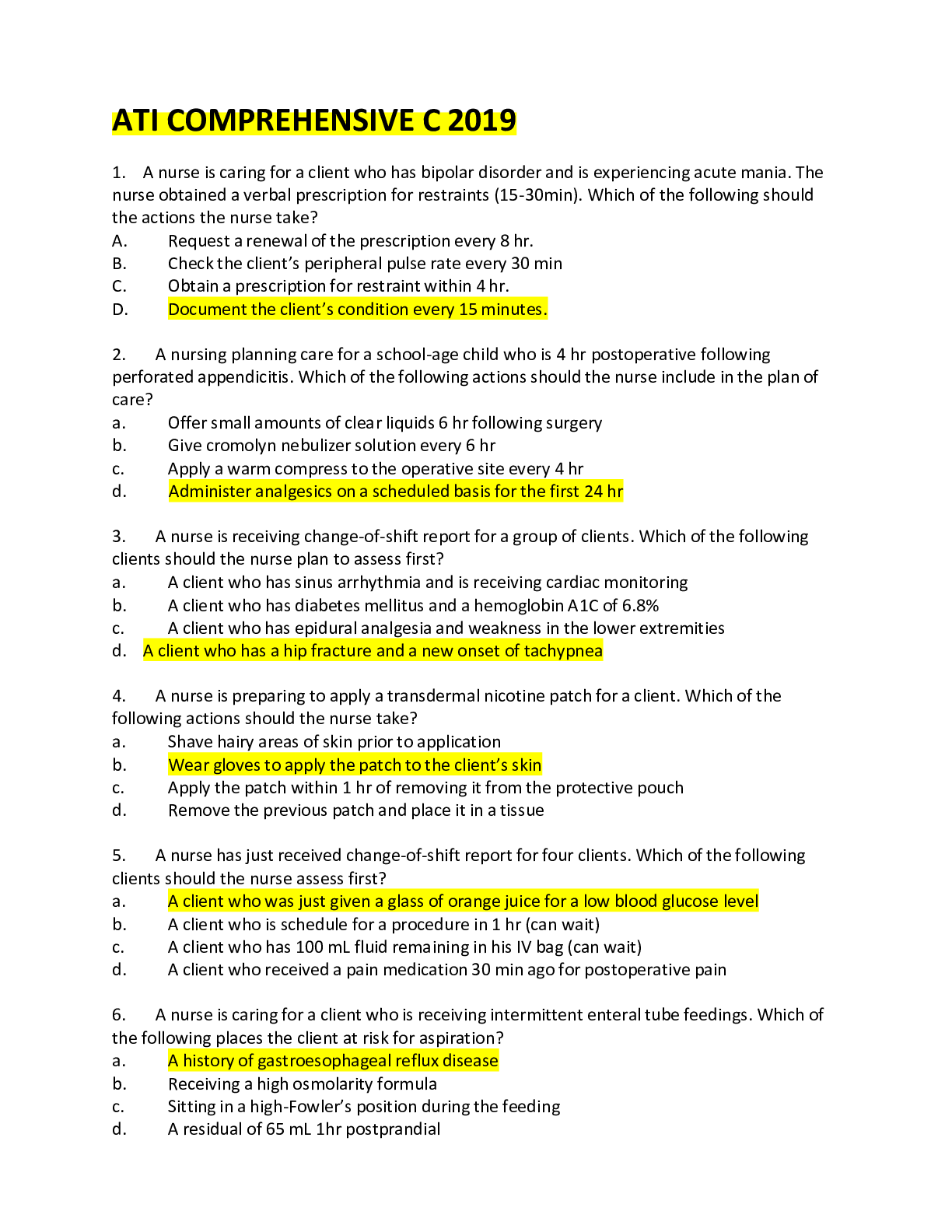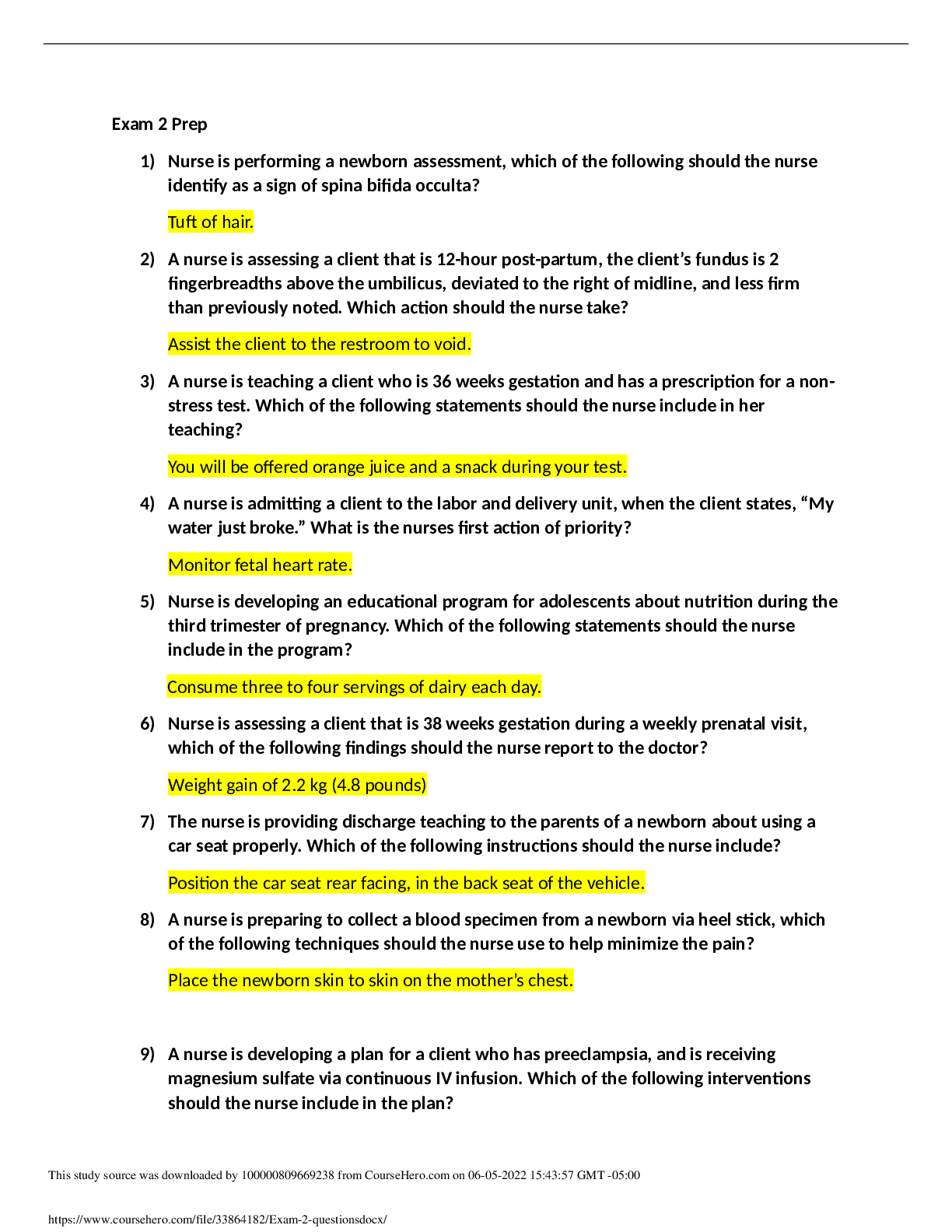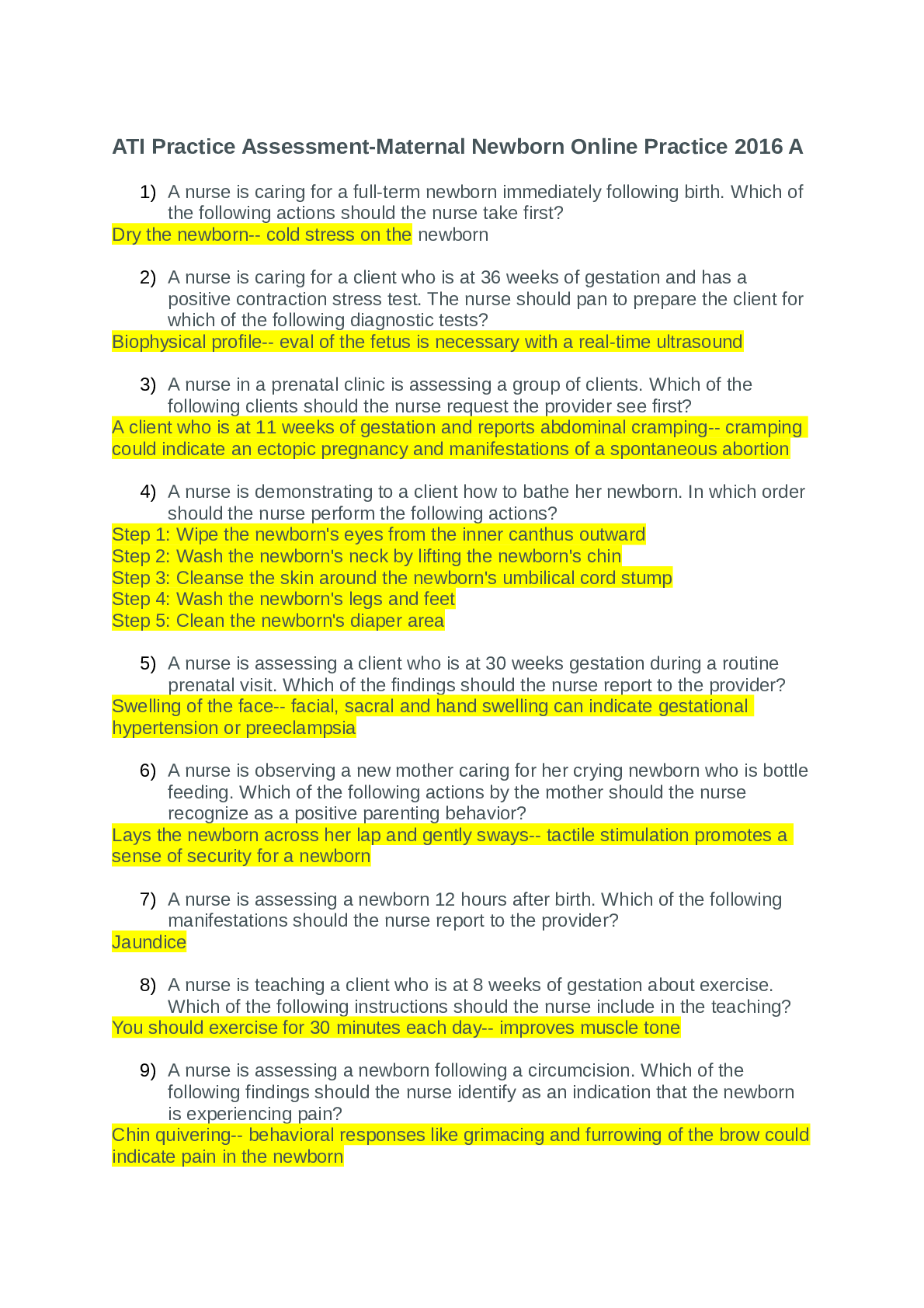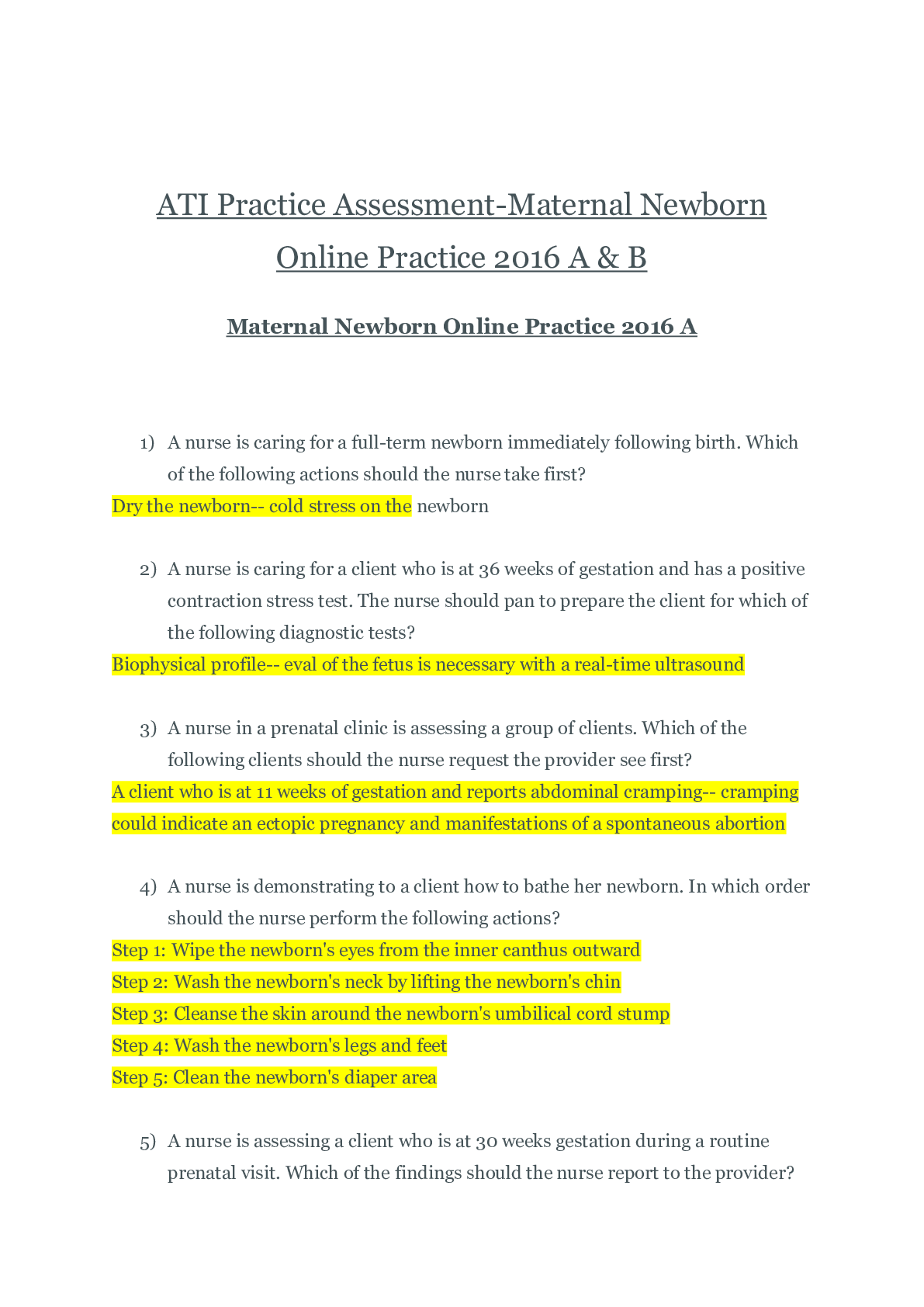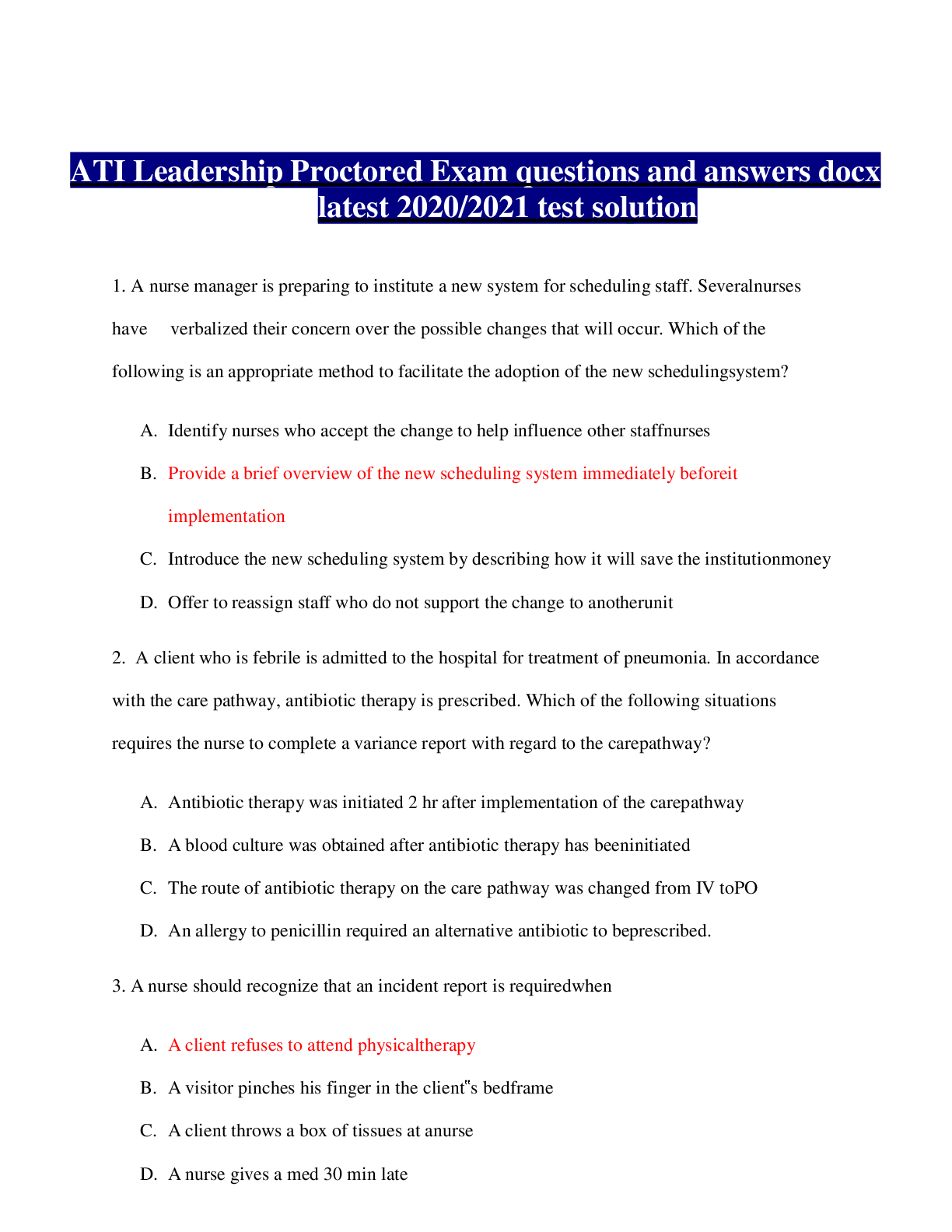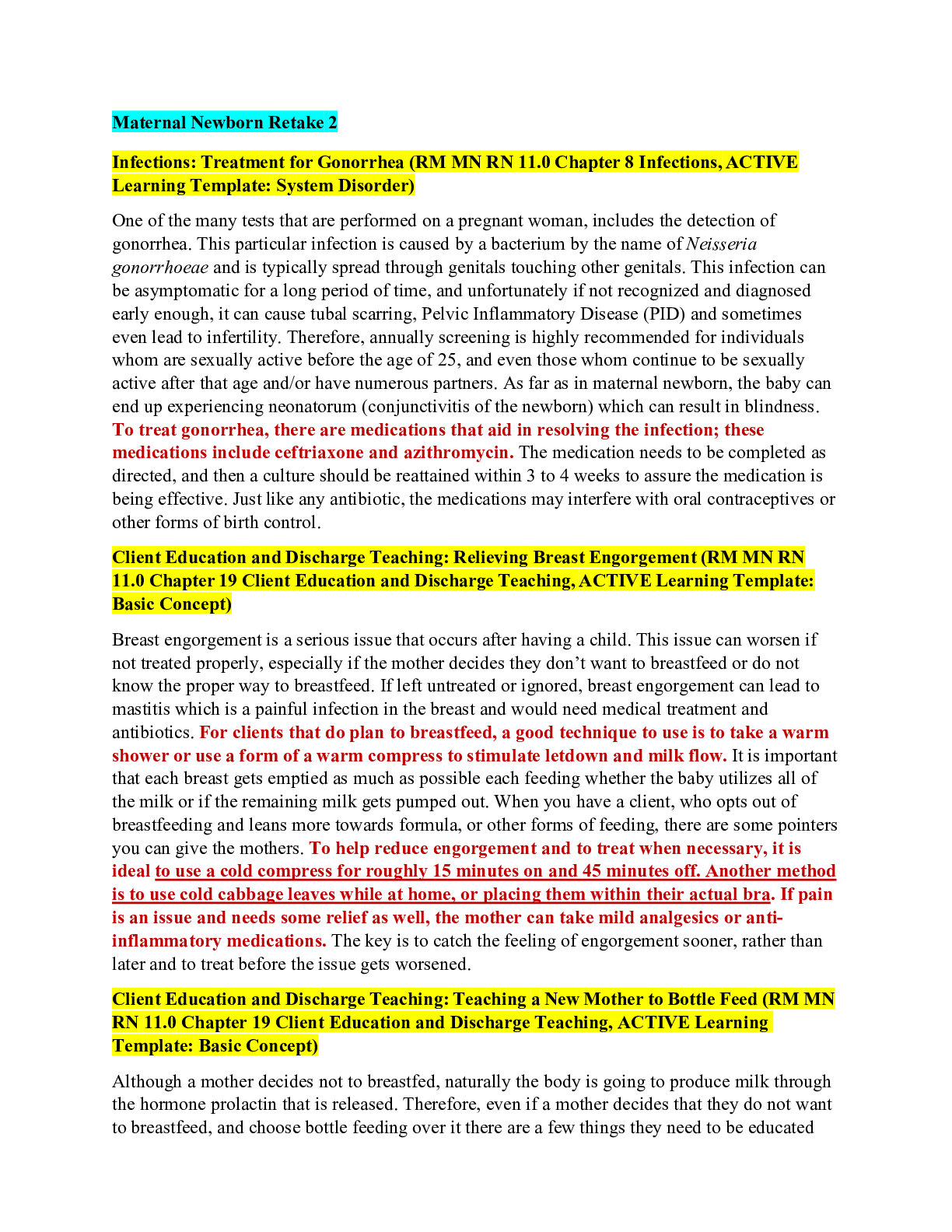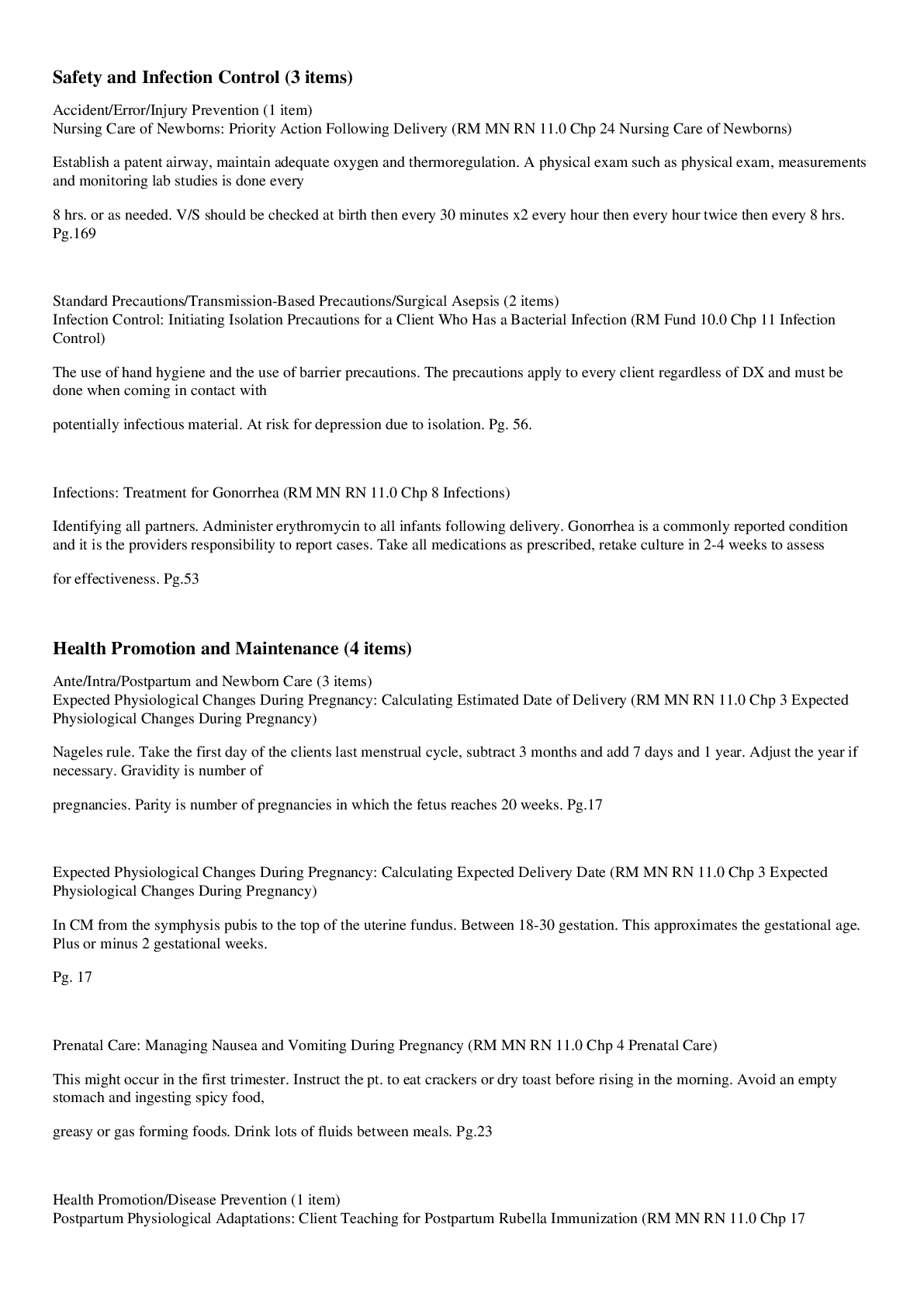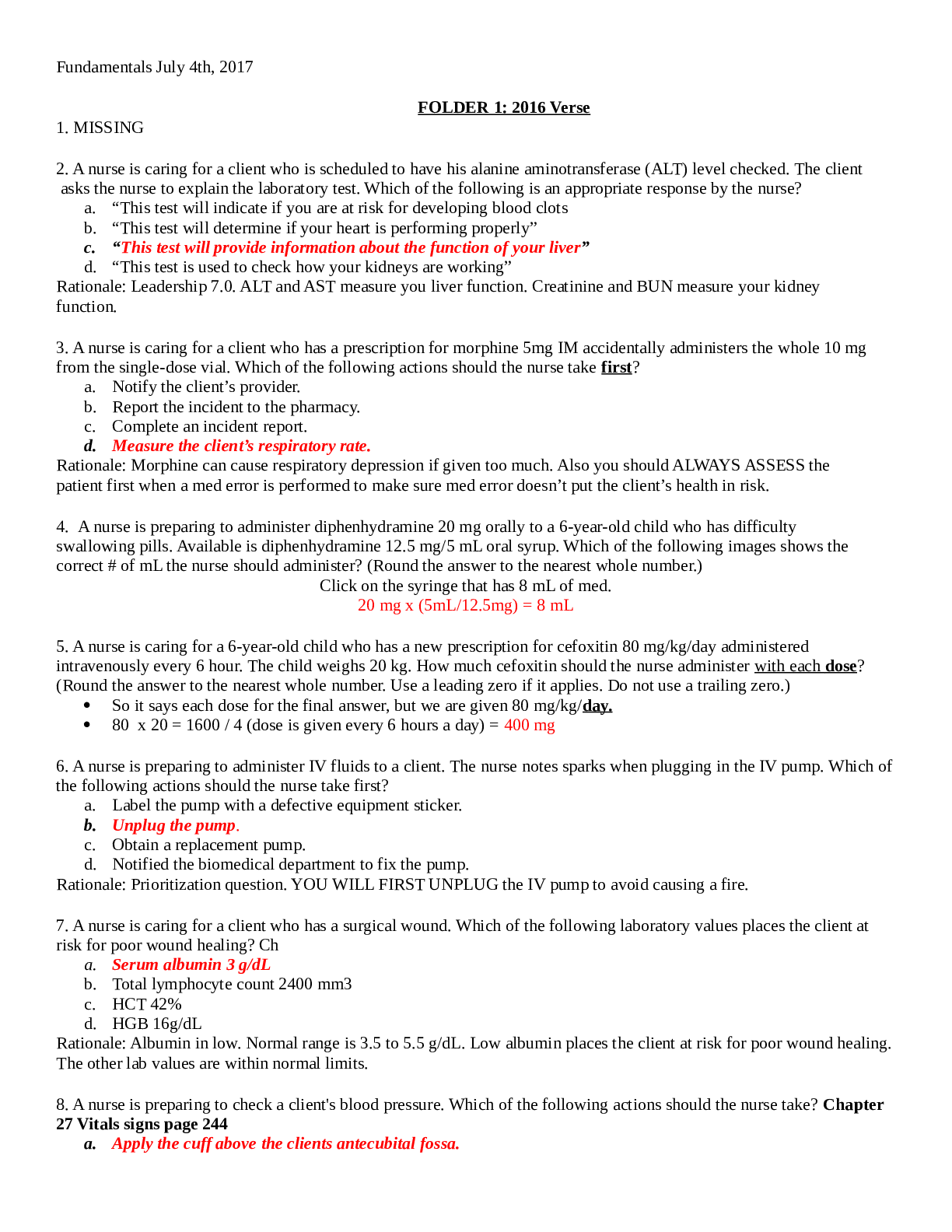*NURSING > QUESTIONS and ANSWERS > ATI RN Maternal Newborn Online Practice 2019 A&B,100% CORRECT (All)
ATI RN Maternal Newborn Online Practice 2019 A&B,100% CORRECT
Document Content and Description Below
ATI RN Maternal Newborn Online Practice 2019 A&B 1. A nurse is caring for a client who has uterine atony and is experiencing postpartum hemorrhage. Which of the following actions is the nurse’s pri... ority? • Massage the client’s fundus Uterine atony and postpartum hmorrhage indicate that this client is at the greatest risk for hypovolemic shock. This can compromise the client’s vital organs, which can lead to death. Therefore, the nurse’s priority is to massage the client’s fundus to minimize blood loss. 2. A nurse is caring for a client who is to receive oxytocin to augment her labor. Which of the following findings contraindicates the initiation of the oxytocin infusion and should be reported to the provider? • Late decelerations Late decelerations are indicative of uteroplacental insufficiency. Therefore, this is a contraindication for the administration of oxytocin and should be reported to the provider. 3. A nurse is assessing a client who has severe preeclampsia. Which of the following manifestations should the nurse expect? • Blurred vision The nurse should identify that a client who has severe preeclampsia can have arteriolar vasospasms and decreased blood flow to the retina which can lead to visual disturbances, such as blurred vision, double vision, or dark spots in the visual field. 4. A nurse is assessing a client who is 1 day-postpartum and has a vaginal hematoma. Which of the following manifestation should the nurse expect? • Vaginal pressure • The nurse should expect a client who has a vaginal hematoma to report pressure in the vagina due to the blood that leaked into the tissues. 5. A nurse is caring for a client who is at 36 weeks of gestation and has a positive contraction stress test. The nurse should plan to prepare the client for which of the following diagnostic tests? • Biophysical profile • A positive contraction stress test indicates that further evaluation of the fetus is necessary. A biophysical profile will provide further evaluation with a real-time ultrasound. 6. A nurse is providing teaching for a client who has a new prescription for combined oral contraceptives. Which of the following findings should the nurse include as an adverse effect of this medication? • Depression • The nurse should instruct the client that depression is a common adverse effect of combined oral contraceptives. Other common adverse effects of the medication include amenorrhea, weight gain, headache, nausea, breatkthrough bleeding, and breast tenderness. 7. A nurse is caring for a postpartum client who is receiving heparin via a continuous IV infusion for thrombophlebitis in her left calf. Which of the following actions should the nurse take? • Maintain the client on bed rest • The client should remain on bed rest to decrease the risk of dislodging the clot, which could cause a pulmonary emoblism. Elevation of the affected leg is recommended. 8. A nurse is providing teaching to a client who is at 40 weeks of gestation and has a new prescription for misoprostol. Which of the following instructions should the nurse include in the teaching? • “I can administer oxytocin 4 hours after the insertion of the medication.” • The nurse can administer oxytocin no sooner than 4 hr after the last dose of misoprostol. Oxytocin can be administered following misoprostol for clients who have cervical ripening and have not begun labor. 9. A nurse is assessing four newborns. Which of the following findings should the nurse report to the provider? • A newborn who is 18 hr old and has an axillary temperature of 37.7 C (99.9 F). • An axillary temperature greater than 37.5 degrees (99.5 degrees F) is above the expected reference range for a newborn and can be an indication of sepsis. Therefore, the nurse should report this finding to the provider. 10. A nurse is caring for a client who is at 30 weeks of gestation and has a prescription for magnesium sulfate IV to treat preterm labor. The nurse should notify the provider of which of the following adverse effects? • Respiratory rate 10/min • The nurse should report a respiratory rate of less than 12/min to the provider, because this is a manifestation of magnesium toxicity. The nurse should ensure that the antidote, calcium gluconate, is readily available. 11. A nurse is teaching a client who is at 10 weeks of gestation about nutrition during pregnancy. Which of the following statements by the client indicates an understanding of the teaching? • “I should take 600 micrograms of folic acid each day.” • A client who is pregnant should increase folic acid intake to 600 mcg daily. Folic acid assists with preventing neural tube birth defects 12. A nurse is assessing a late preterm newborn. Which of the following manifestations is an indication of hypoglycemia? • Respiratory distress • Late preterm newborns are at an increased risk for hypoglycemia due to decreased glycogen stores and immature insulin secretion. Respiratory distress is a manifestation of hypoglycemia. Other manifestation of hypoglycemia include an abnormal cry, jitteriness, lethargy, poor feeding, apnea and seizures. 13. • 14. A nurse is demonstrating to a client how to bathe their newborn. In which order should the nurse perform the following actions? (Put in order) • Nurse should first wipe the newborn’s eyes from the inner canthus outward using plain water • Wash the newborn’s neck by lifting the newborn’s chest • Nurse should cleanse the skin around the umbilical cord stump • Wash the newborn’s legs and feet • 15. A nurse is teaching a newly licensed nurse about collecting a specimen for the universal newborn screening. Which of the following statements should the nurse include in the teaching? • “Ensure that the newborn has been receiving feedings for 24 hours prior to obtaining the specimen.” • 16. A nurse is creating a plan of care for a client who is postpartum ad adheres to traditional Hispanic cultural beliefs. Which of the following cultural practices should the nurse include in the plan of care? • Protect the client’s head and feet from cold air. • 17. A nurse is assessing a newborn who was born at 26 weeks of gestation using the New Ballard score. Which of the following finding should the nurse expect? • Minimal arm recoil • 18. A nurse is caring for a client who is at 15 weeks of gestation, is Rh-negative, and has just had an amniocentesis. Which of the following interventions is the nurse’s priority following the procedure? • Monitor the FHR • 19. A nurse is assessing a newborn who is 16 hr old. Which of the following findings should the nurse report to the provider? • Substernal retractions • 20. A nurse is performing a physical assessment of a newborn upon admission to the nursery. Which of the following manifestation should the nurse expect? (Select all that apply). • Acrocyanosis • Positive Babinski reflex • Two umbilical arteries visible 21. A nurse is caring for a client who is experiencing preeclampsia and has a new prescription for IV magnesium sulfate. Which of the following medications should the nurse anticipate administering if the client develops magnesium toxicity? • Calcium gluconate • 22. A nurse is teaching a client who is at 37 weeks of gestation and has a prescription for a nonstress test. Which of the following instructions the nurse include? • “You should press the handheld button when you feel your baby move.” • 23. A nurse is providing education about family bonding to parents who recently adopted a newborn. The nurse should make which of the following suggestions to aid the family’s 7-year old child in accepting the new family member? • Obtain a gift from the newborn to present to the sibling. • Presenting a gift from the newborn to the sibling is a strategy to facilitate a school-age sibling’s acceptance of a new family member, this ensures that the sibling does not feel left out and that they understand their role in the family. 24. A nurse is caring for a client who is at 35 weeks of gestation and is undergoing a nonstress test that reveals a variable decelration in the FHR. Which of the following actions should the nurse take? • Have the client change position • 25. A nurse is assessing a client who is at 38 weeks of gestation during a weekly prenatal visit. Which of the following findings should the nurse report to the provider? • Weight gain of 2.2 kg (4.8 lb) • 26. A nurse is providing teaching for a client who gave birth 2 hr ago about the facility policy for newborn safety. Which of the following client statements indicates an understanding of the teaching? • “The person who comes to take my baby’s pictures will be wearing a photo identification badge.” • 27. A nurse is assessing a client who is receiving morphine via IV bolus for pain following a cesarean birth. The nurse notes a respiratory rate of 8/min. Which of the following medications should the nurse administer? • Naloxone • 28. A nurse is performing a routine assessment on a client who is at 18 weeks of gestation. Which of the following findings should the nurse expect? • FHR 152/min • 29. A nurse in an antepartum clinic is providing care for a client who is at 26 weeks of gestation. Upon reviewing the client’s medical record, which of the following findings should the nurse report to the provider? BP: 130/78 mmHg, Respiratory rate: 20/min, Heart rate: 90/min Diagnostic results: Hgb: 12 g/dL, Hct: 34%, 1-hr glucose tolerance test 120 mg/dL Progress notes: Fundal height 30 cm, good fetal movement, not experiencing headache, dizziness, blurred vision, or vaginal bleeding, fetal heart rate 110/min. • Fundal height measurement • 30. A nurse is developing a plan of care for a newborn who is to undergo phototherapy for hyperbilirubinemia. Which of the following should the nurse include in the plan? • Remove all clothing from the newborn except the diaper. • The nurse should remove all the newborn’s clothing except the diaper while under phototherapy. Maximum skin exposure to the ultraviolet light is needed to break down the excess bilirubin. 31. A nurse is assessing a newborn who was delivered vaginally and experienced a tight nuchal cord. Which of the following findings should the nurse expect? • Petechiae over the head • 32. A nurse is caring for a client who is at 38 weeks of gestation. Which of the following actions should the nurse take prior to applying an external transducer for fetal monitoring? • Perform Leopold Maneuvers • 33. A nurse is assessing a newborn 12 hr after birth. Which of the following manifestations should the nurse report to the provider? • Jaundice • 34. A nurse is transporting a newborn back to the parent’s room following a procedure. Which of the following actions should the nurse take? • Verify that the parent’s identification band matches the newborn’s identification band. • 35. A nurse is caring for a client who is at 32 weeks of gestation and has gonorrhea. The nurse should identify that the client is at increased risk for which of the following complications? • Premature rupture of membranes The nurse should identify that a client who is pregnant and has gonorrhea is at an increased risk for premature rupture of membranes, chorioamnionitis, preterm birth, neonatal sepsis, and intrauterine growth restriction 36. A nurse is reviewing the prenatal laboratory results for a client who is at 12 weeks of gestation following an initial prenatal visit. Which of the following laboratory findings should the nurse report to the provider? • Hemoglobin 10 g/dL A hemoglobin of 10 g/dL is below the expected reference range of greater than 11 g/dL for a client who is pregnant. The nurse should report this finding to the provider to obtain a prescription for ferrous iron supplementation because of anemia. 37. A nurse in an antepartum clinic is assessing a client who is at 32 weeks of gestation. Which of the following findings should the nurse report to the provider? • Report of decreased fetal movement • The nurse should identify that a client who reports decreased fetal movement could be experiencing a complication related to fetal well-being. A decrease in fetal movement can indicate fetal distress. 38. A nurse is caring for a client who is at 36 weeks of gestation and has a prescription for an amniocentesis. For which of the following reasons should the nurse prepare the client for an ultrasound? • To locate the pocket of fluid 39. A nurse is caring for a client who is at 26 weeks of gestation and has epilepsy. The nurse enters the room and observes the client having a seizure. After turning the client’s head to one side, which of the following actions should the nurse take immediately after the seizure? • Administer oxygen via a nonrebreather mask. When using the airway, breathing and circulation approach to client care, the nurse should place the priority on administering oxygen to the client via a nonrebreather mask at 10 L/min to ensure adequate oxygenation to the fetus. 40. 41. A nurse is caring for a client who has hyperemesisgravidarum and is receiving IV fluid replacement. Which of the following findings should the nurse report to the provider? • BUN 25 mg/dL • The nurse should report an elevated BUN to the provider since it can indicate dehydration. 42. A nurse is caring for a prenatal client who has parvovirus B19 (fifth disease). Which of the following actions should the nurse take? • Schedule an ultrasound examination. Nurse should schedule serial ultrasound examinations to monitor the fetus during the pregnancy to detect the possible development of fetal hydrops. Also, the virus can cause miscarriage, intrauterine growth restriction, fetal anemia, or stillbirth. 43. A nurse is developing a plan of care for a client who has preeclampsia and is receiving magnesium sulfate via a continuous IV infusion. Which of the following interventions should the nurse include in the plan? • Monitor the FHR continuously. Magnesium sulfate, which is used to prevent seizure in clients who have preeclampsia, is a high-alert medication that requires close monitoring. The FHR and uterine contractions should be monitored continuously while the client is receiving magnesium sulfate. 44. A nurse in a provider’s office is reviewing the medical record of a client who is in the first trimester of pregnancy. Which of the following findings should the nurse identify as a risk factor for the development of preeclampsia? • Pregestational diabetes mellitus • Pregestational diabetes mellitus increases a client’s risk for the development of preeclampsia. Other risk factors include preexisting HTN, renal disease, SLE, rheumatoid arthritis. 45. A nurse is providing teaching to a client about the physiological changes that occur during pregnancy. The client is at 10 weeks of gestation and has a BMI within the expected reference range. Which of the following client statements indicates an understanding of the teaching? • “I will likely need to use alternative positions for sexual intercourse.” 46. A nurse is performing a vaginal examination on a client who is in labor and observes the umbilical cord protruding from the vagina. After calling for assistance, which of the following actions should the nurse take? • Insert two gloved fingers into the vagina and apply upward pressure to the presenting part. • 47. A nurse is providing discharge teaching to a client who had a cesarean birth 3 days ago. Which of the following instructions should the nurse include? • “You can still become pregnant if you are breastfeeding.” • 48. A nurse is providing teaching about nonpharmacological pain management to a client who is breastfeeding and has engorgment. The nurse should recommend the application of which of the following items? • Cold cabbage leaves • 49. A nurse is observing a new parent caring for her crying newborn who is bottle feeding. Which of the following actions by the parent should the nurse recognize as positive parenting behavior? • Lays the newborn across her lap and gently sways • This is a correct technique for quieting a newborn. This tactile stimulation promotes a sense of security for the newborn. 50. A nurse is assessing a client who received carboprost for postpartum hemorrhage. Which of the following findings is an adverse effect of this medication? • HTN • 51. A nurse is preparing to collect a blood specimen from a newborn via a heel stick. Which of the following techniques should the nurse use to help minimize the pain of the procedure for the newborn? • Place the newborn skin to skin on the mother’s chest. • Placing the newborn skin to skin on the mother’s chest is an effective technique to significantly decrease the newborn’s pain level and anxiety. The nurse should implement this technique before, during and after the procedure. 52. A nurse is assessing a client who has gestational diabetes mellitus and is experiencing hyperglycemia. Which of the following findings should the nurse expect? • Reports increased urinary output • Increased urinary output, nausea and vomiting, reports of thirst, abdominal pain, constipation, drowsiness, and headaches are manifestations of hyperglycemia. Other manifestations include weak rapid pulse, fruity breath odor, urine positive for sugar and acetone, and a blood glucose level greater than 200 mg/dL. 53. A charge nurse on a labor and delivery unit is teaching a newly licensed nurse how to perform Leopold maneuvers. Which of the following images indicates the first step of Leopold maneuvers? • • 54. a nurse is admitting a client to the labor and delivery unit when the client states, “My water just broke.” Which of the following interventions is the nurse’s priority? • Begin FHR monitoring The greatest risk to the client and her fetus following a rupture of membranes is umbilical cord prolapse. The nurse should monitor the fetus closely to ensure well-being. Therefore, this is the priority action the nurse should take. 55. A nurse is caring for a client who is at 24 weeks of gestation and has a suspected placental abruption. Which of the following laboratory tests should the nurse expect the provider to prescribe? • Kleihauer-Betke test The nurse should expect the provider to prescribe a Kleihauer-Betke test for a client who has suspected placental abruption to determine if fetal blood is in maternal circulation. This test is useful to determine if Rho (D) immune globulin therapy should be administered to a client who is Rh-negative. 56. A nurse is performing a physical assessment of a newborn. Which of the following clinical findings should the nurse expect? (Select all that apply). • Heart rate 154/min • Respiratory rate 58/min • Weight 2.6 kg (5 lb 12 oz) 57. A nurse is assessing a client who is at 36 weeks of gestation. Which of the following findings should the nurse report to the provider? • Visual disturbances • 58. A nurse is preparing to administer magnesium sulfate 2 g/hr IV to a client who is preterm labor. Available is 20 g magnesium sulfate in 500 mL of dextrose 5% in water (D5W). The nurse should set the IV infusion pump to administer how many mL/hr? (Round the answer to the nearest whole number. Use a leading zero if it applies. Do not use a trailing zero.) • 50 mL 59. A nurse is admitting a client who is in labor. The client admits to recent cocaine use. For which of the following complications should the nurse assess? • Abruptio placenta • Cocaine use increases the risk for vasoconstriction and possible abruptio placenta. 60. A nurse is caring for a client who is anemic at 32 weeks of gestation and is in preterm labor. The provider prescribed betamethasone 12 mg IM. Which of the following outcomes should the nurse expect? • A reduction in respiratory distress in the newborn • Betamethasone is a glucocorticoid that is given to stimulate fetal lung maturity and prevent respiratory distress Maternal Newborn Online Practice (2019 B) 1. 2. A nurse is caring for a client following an amniocentesis at 18 weeks of gestation. Which of the following findings should the nurse report to the provider as a potential complication? • Leakage of fluid from the vagina • 3. A nurse is calculating a client’s expected date of birth using Nagele’s rule. The client tells the nurse that her last menstrual cycle started on November 27th. Which of the following dates is the client’s expected date of birth? • September 3rd 4. A nurse is caring for a client who is at 41 weeks of gestation and has a positive contraction stress test. For which of the following diagnostic tests should the nurse prepare the client? • Biophysical profile (BPP) • The nurse should prepare the client for a BPP to further assess fetal well-being. A positive contraction stress test indicates there is potential uteroplacental insufficiency. A BPP uses a real time ultrasound to visualize physical and physiological characteristics of the fetus and observe for fetal biophysical responses to stimuli. 5. A nurse is teaching a new parent about newborn safety. Which of the following instructions should the nurse include in the teaching? • “You can share your room with your baby for the next few weeks.” The nurse should recommend room-sharing during the first few weeks. This allows the parent to be readily available to the newborn and learn the newborn’s cues. However, the nurse should instruct the parent to avoid placing the newborn in their bed as it increases risk for sudden infant death syndrome (SIDS). 6. A nurse is caring for a client who is in labor and whose fetus is in the right occiput posterior position. The client is dilated to 8 cm and reports back pain. Which of the following actions should the nurse take? • Apply sacral counterpressure. The nurse should apply sacral counterpressure to assist in relieving back labor pain related to fetal posterior position. 7. A nurse is caring for a newborn who is undergoing phototherapy to treat hyperbilirubinemia. Which of the following actions should the nurse take? • Cover the newborn’s eyes while under the phototherapy light. Applying an opaque eye mask prevents damage to the newborn’s retinas and corneas form the phototherapy light. 8. A nurse is performing a vaginal examination on a client who is in labor and observes the umbilical cord protruding from the vagina. After calling for assistance, which of the following actions should the nurse take next? • Apply internal upward pressure to the presenting part using two gloved fingers. Using EBP, the first action should take is to apply internal upward pressure to the presenting part. Prolapse of the umbilical cord during labor can result in decreased perfusion to the fetus, which can lead to hypoxia. After calling for assistance, the nurse should relieve the compression on the umbilical cord by applying upward internal pressure on the presenting part with two gloved fingers. The nurse should not move their hand. 9. A nurse is preparing to administer oxytocin to a client who is postpartum. Which of the following findings is an indication for the administration of the medication? (Select all that apply). • Flaccid uterus • Excess vaginal bleeding 10. A nurse is teaching a postpartum client about steps the nurses will take to promote the security and safety of the client’s newborn. Which of the following statements should the nurse take? • “Staff members who take care of your baby will be wearing a photo identification badge.” 11. A nurse is assessing the newborn of a client who took a selective serotonin reuptake inhibitor (SSRI) during pregnancy. Which of the following manifestations should the nurse identify as an indication of withdrawal from an SSRI? • Vomiting Expected manifestations associated with fetal exposure to SSRIs include irritability, agitation, tremors, diarrhea, and vomiting. These manifestations typically last 2 days. 12. A nurse is assessing fetal heart tones for a client who is pregnant. The nurse has determined the fetal position as left occipital anterior. To which of the following areas of the client’s abdomen should the nurse apply the ultrasound transducer to assess the point of maximum intensity of the fetal heart? • Left lower quadrant • The fetal heart tones of a fetus in the left occipital anterior position are best heard in the left lower quadrant The fetal heart tones of a fetus in the left occipital anterior position are best heard in the right upper quadrant. 13. A nurse is teaching a new mother how to use a bulb syringe to suction her newborn’s secretions. Which of the following instructions should the nurse include? • Stop suctioning when the newborn’s cry sounds clear The nurse should instruct the client to stop suctioning when the newborn’s cry no longer sounds like it is coming through a bubble of fluid or mucus. 14. A nurse is reviewing the medical record of a client who is postpartum and has preeclampsia. Which of the following laboratory results should the nurse report to the provider? • Platelets 50,000/mm3 15. A • 16. [Show More]
Last updated: 1 year ago
Preview 1 out of 10 pages
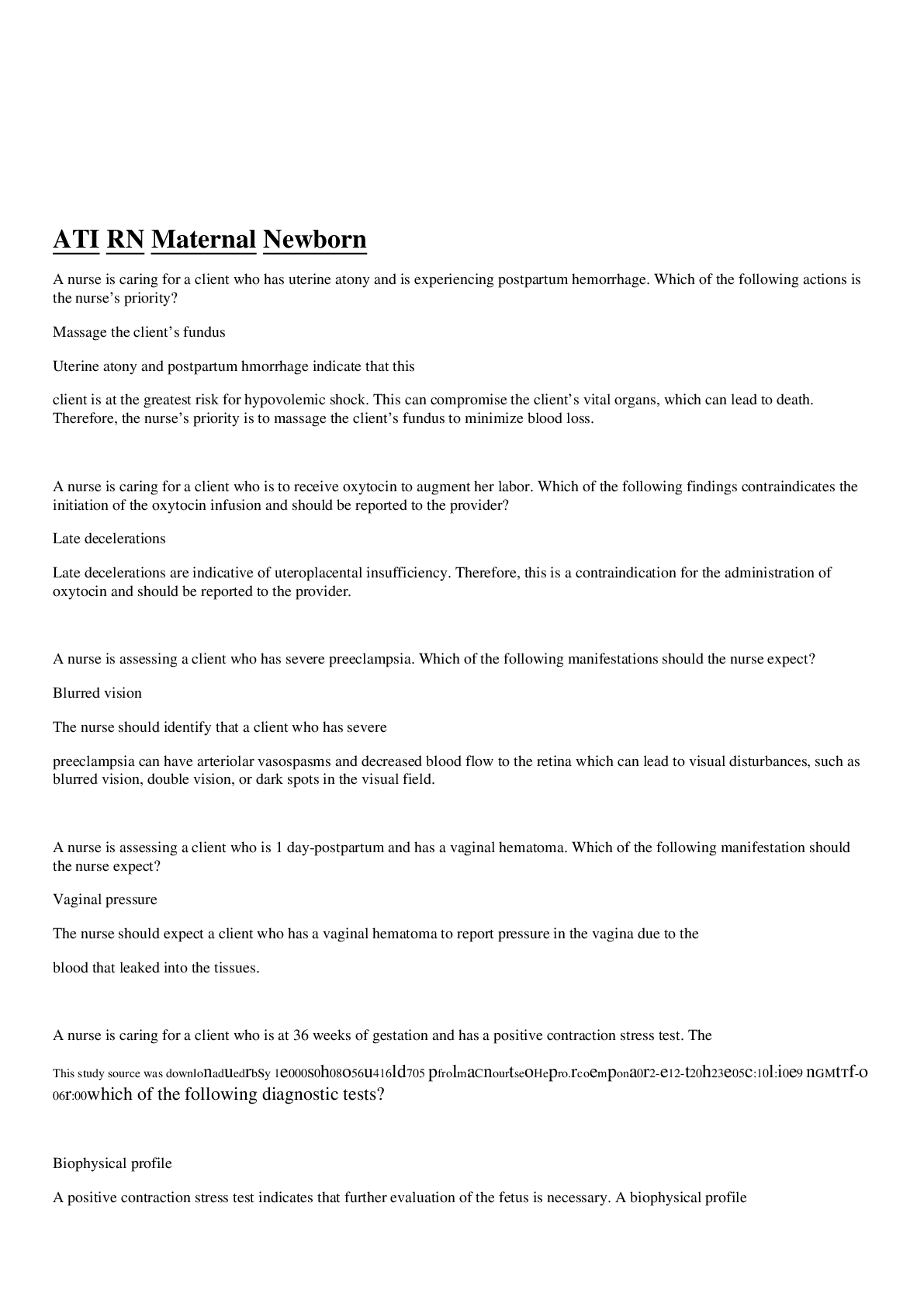
Reviews( 0 )
Document information
Connected school, study & course
About the document
Uploaded On
Mar 02, 2021
Number of pages
10
Written in
Additional information
This document has been written for:
Uploaded
Mar 02, 2021
Downloads
0
Views
64

